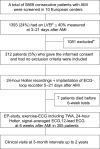Prediction of fatal or near-fatal cardiac arrhythmia events in patients with depressed left ventricular function after an acute myocardial infarction
- PMID: 19155249
- PMCID: PMC2655314
- DOI: 10.1093/eurheartj/ehn537
Prediction of fatal or near-fatal cardiac arrhythmia events in patients with depressed left ventricular function after an acute myocardial infarction
Abstract
Aims: To determine whether risk stratification tests can predict serious arrhythmic events after acute myocardial infarction (AMI) in patients with reduced left ventricular ejection fraction (LVEF < or = 0.40).
Methods and results: A total of 5869 consecutive patients were screened in 10 European centres, and 312 patients (age 65 +/- 11 years) with a mean LVEF of 31 +/- 6% were included in the study. Heart rate variability/turbulence, ambient arrhythmias, signal-averaged electrocardiogram (SAECG), T-wave alternans, and programmed electrical stimulation (PES) were performed 6 weeks after AMI. The primary endpoint was ECG-documented ventricular fibrillation or symptomatic sustained ventricular tachycardia (VT). To document these arrhythmic events, the patients received an implantable ECG loop-recorder. There were 25 primary endpoints (8.0%) during the follow-up of 2 years. The strongest predictors of primary endpoint were measures of heart rate variability, e.g. hazard ratio (HR) for reduced very-low frequency component (<5.7 ln ms(2)) adjusted for clinical variables was 7.0 (95% CI: 2.4-20.3, P < 0.001). Induction of sustained monomorphic VT during PES (adjusted HR = 4.8, 95% CI, 1.7-13.4, P = 0.003) also predicted the primary endpoint.
Conclusion: Fatal or near-fatal arrhythmias can be predicted by many risk stratification methods, especially by heart rate variability, in patients with reduced LVEF after AMI.
Trial registration: ClinicalTrials.gov NCT00145119.
Figures




Comment in
-
Prediction of fatal or near fatal arrhythmias in patients with a depressed left ventricular function after an acute myocardial infarction.Eur Heart J. 2009 May;30(10):1288. doi: 10.1093/eurheartj/ehp166. Epub 2009 Apr 20. Eur Heart J. 2009. PMID: 19380348 No abstract available.
Similar articles
-
Risk factors of self-terminating and perpetuating ventricular tachyarrhythmias in post-infarction patients with moderately depressed left ventricular function, a CARISMA sub-analysis.Europace. 2011 Nov;13(11):1604-11. doi: 10.1093/europace/eur166. Epub 2011 Jun 28. Europace. 2011. PMID: 21712280
-
Prediction of late arrhythmic events after acute myocardial infarction from combined use of noninvasive prognostic variables and inducibility of sustained monomorphic ventricular tachycardia.Am J Cardiol. 1993 May 15;71(13):1131-41. doi: 10.1016/0002-9149(93)90635-p. Am J Cardiol. 1993. PMID: 8480637
-
Arrhythmic risk stratification in post-myocardial infarction patients with preserved ejection fraction: the PRESERVE EF study.Eur Heart J. 2019 Sep 14;40(35):2940-2949. doi: 10.1093/eurheartj/ehz260. Eur Heart J. 2019. PMID: 31049557 Free PMC article. Clinical Trial.
-
Heart rate variability in risk stratification of cardiac patients.Prog Cardiovasc Dis. 2013 Sep-Oct;56(2):153-9. doi: 10.1016/j.pcad.2013.07.003. Epub 2013 Aug 12. Prog Cardiovasc Dis. 2013. PMID: 24215747 Review.
-
Arrhythmic risk stratification of post-myocardial infarction patients.Curr Opin Cardiol. 2000 Jan;15(1):1-6. doi: 10.1097/00001573-200001000-00001. Curr Opin Cardiol. 2000. PMID: 10666655 Review.
Cited by
-
Clinical application of heart rate variability after acute myocardial infarction.Front Physiol. 2012 Feb 27;3:41. doi: 10.3389/fphys.2012.00041. eCollection 2012. Front Physiol. 2012. PMID: 22375128 Free PMC article.
-
Association between Tp-e/QT ratio and prognosis in patients undergoing primary percutaneous coronary intervention for ST-segment elevation myocardial infarction.Clin Cardiol. 2012 Sep;35(9):559-64. doi: 10.1002/clc.22022. Epub 2012 Jun 27. Clin Cardiol. 2012. PMID: 22740086 Free PMC article.
-
The significance of heart rate turbulence in predicting major cardiovascular events in patients after myocardial infarction treated invasively.Ann Noninvasive Electrocardiol. 2012 Jul;17(3):230-40. doi: 10.1111/j.1542-474X.2012.00510.x. Ann Noninvasive Electrocardiol. 2012. PMID: 22816542 Free PMC article.
-
Effect of trehalose on heart functions in rats model after myocardial infarction: assessment of novel intraventricular pressure and heart rate variability.Front Cardiovasc Med. 2023 Jun 21;10:1182628. doi: 10.3389/fcvm.2023.1182628. eCollection 2023. Front Cardiovasc Med. 2023. PMID: 37469485 Free PMC article.
-
Does heart rate variability correlate with long-term prognosis in myocardial infarction patients treated by early revascularization?World J Cardiol. 2017 Jan 26;9(1):27-38. doi: 10.4330/wjc.v9.i1.27. World J Cardiol. 2017. PMID: 28163834 Free PMC article.
References
-
- Camm AJ, Pratt CM, Schwartz PJ, Al-Khalidi HR, Spyt MJ, Holroyde MJ, Karam R, Sonnenblick EH, Brum JM AzimiLide post Infarct surVival Evaluation (ALIVE) Investigators. Mortality in patients after a recent myocardial infarction: a randomized, placebo-controlled trial of azimilide using heart rate variability for risk stratification. Circulation. 2004;109:990–996. - PubMed
-
- Solomon SD, Zelenkofske S, McMurray JJ, Finn PV, Velazquez E, Ertl G, Harsanyi A, Rouleau JL, Maggioni A, Kober L, White H, Van de Werf F, Pieper K, Califf RM, Pfeffer MA Valsartan in Acute Myocardial Infarction Trial (VALIANT) Investigators. Sudden death in patients with myocardial infarction and left ventricular dysfunction, heart failure, or both. N Engl J Med. 2005;352:2581–2588. - PubMed
-
- Hohnloser SH, Kuck KH, Dorian P, Roberts RS, Hampton JR, Hatala R, Fain E, Gent M, Connolly SJ DINAMIT Investigators. Prophylactic use of an implantable cardioverter-defibrillator after acute myocardial infarction. N Engl J Med. 2004;351:2481–2488. - PubMed
-
- Huikuri HV, Castellanos A, Myerburg RJ. Sudden death due to cardiac arrhythmias. N Engl J Med. 2001;345:1473–1482. - PubMed
-
- Moss AJ, Zareba W, Hall WJ, Klein H, Wilber DJ, Cannom DS, Daubert JP, Higgins SL, Brown MW, Andrews ML Multicenter Automatic Defibrillator Implantation Trial II Investigators. Prophylactic implantation of a defibrillator in patients with myocardial infarction and reduced ejection fraction. N Engl J Med. 2002;346:877–883. - PubMed

